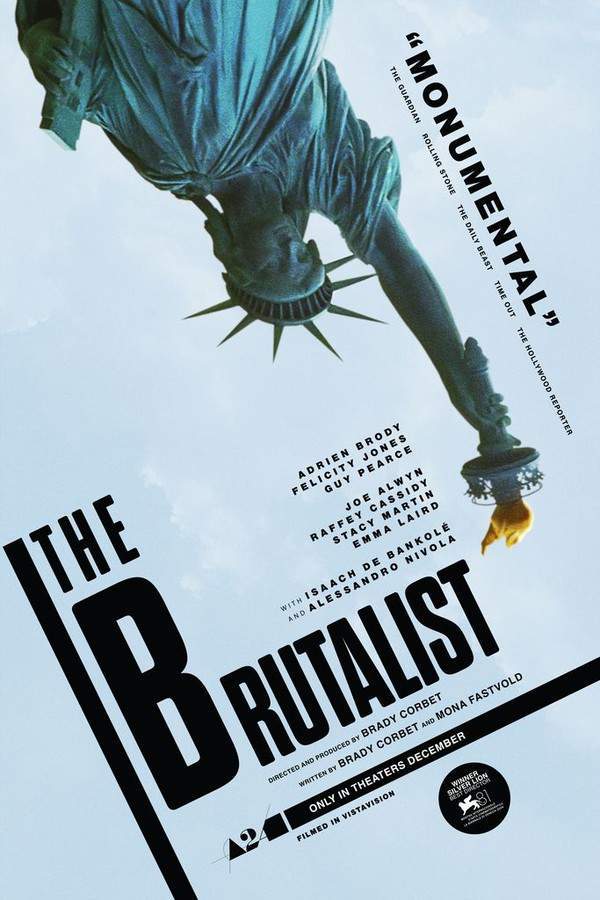
The Brutalist 2024
Made by

Brookstreet Pictures
Test your knowledge of The Brutalist with our quiz!
The Brutalist Plot Summary
Read the complete plot summary and ending explained for The Brutalist (2024). From turning points to emotional moments, uncover what really happened and why it matters.
After surviving the horrors of the Holocaust, Hungarian-Jewish architect László Tóth embarks on a new life in the United States, having been forcibly ripped apart from his wife, Erzsébet, and his niece, Zsófia, during the tumultuous times of World War II in Budapest. He finds himself in Philadelphia where, with the assistance of his American wife, Audrey, and his immigrant cousin, Attila, he begins the arduous task of searching for employment to secure a stable future.
In 1947, László takes a step towards success by aiding Attila in managing a furniture business, but fate takes a different turn when his son Harry unexpectedly seeks his help in renovating the study and library of the affluent industrialist Harrison Lee Van Buren Sr.. Upon returning home, however, Harrison is infuriated by the state of the renovations, ordering László and Attila to leave without compensation—a disheartening setback. Tensions mount when Audrey accuses László of pursuing her, which leads to Attila asking him to vacate his house in sorrowful disappointment.
As the years roll on, László finds refuge in charitable housing operated by a church, where he forges a friendship with Gordon, an African-American father grappling with the challenges of raising his young son in poverty. Unbeknownst to Gordon, László has developed a hidden dependency on heroin, and their paths intertwine in a dangerous venture at a shipyard. Unexpectedly, Harrison resurfaces, revealing to László that his architectural talents have garnered admiration within the community, thereby commissioning him to construct a community center dedicated to his late mother—a project that encompasses a library, theater, gymnasium, and chapel. Eager to leave a lasting legacy in America, László dives into this new venture, but his addiction pulls him further down a treacherous path, ultimately complicating the immigration of Erzsébet and Zsófia to the United States.
Part 2: The Hard Core of Beauty
The plot thickens in 1953 when László greets Erzsébet and Zsófia at the train station, only to discover that Erzsébet, now wheelchair-bound due to osteoporosis, and Zsófia, rendered mute by trauma, have been irrevocably changed. Frustration mounts as László faces off against developers who alter the design and materials of the center without his consent. Although he intends to fund the necessary materials himself, Harry disparages him, firmly asserting that László is merely “tolerated”—and worse, he makes lewd remarks about Zsófia, whom László warns against due to the potential abuse she has faced.
The narrative takes a dark turn when a train carrying vital supplies for the center derails, leading to significant injuries and forcing Harrison to halt construction. Years pass; László and Erzsébet have relocated to New York City, where Zsófia has recovered her speech and is starting a family of her own. She shares plans to move to Jerusalem with her husband, urging her family to join despite their reluctant attachment to America.
As Harrison reaches out to László with an offer to complete the community center on a tight budget by sacrificing the library, hope mingles with desperation. To procure stones necessary for completion, László turns to an old ally. Unfortunately, this connection leads to a horrifying encounter—Harrison, asserting dominance, rapes László in the quarry, leaving him traumatized and spiraling into chaos. His temper flares as he alienates friends, neglects professional obligations, and lashes out at innocent workers.
With the pain of witnessing Erzsébet’s struggles intensifying, László reluctantly injects her with heroin, leading to a near-fatal overdose one harrowing night. Exhausted by the trials of life in America, they consider a new beginning in Jerusalem. In a chilling climax, Erzsébet confronts Harrison about the rape, leading to a brutal altercation that forces her into the care of her sister, Maggie.
Epilogue
The story arrives at a poignant close with Erzsébet’s passing in 1980 and a retrospective exhibition highlighting László’s architectural legacy, including the long-delayed community center, finally completed a decade after its initial halt. As Zsófia delivers a speech, she reflects on how their experiences during the Holocaust shaped László’s works, quoting him in the insightful reminder: > “No matter what the others try to sell you, it is the destination, not the journey.”
The Brutalist Timeline
Follow the complete movie timeline of The Brutalist (2024) with every major event in chronological order. Great for understanding complex plots and story progression.
László's Separation
During World War II, Hungarian-Jewish architect László Tóth is forcibly separated from his wife, Erzsébet, and niece, Zsófia, in Budapest. This traumatic event sets the stage for his harrowing journey towards survival and eventual emigration.
Emigration to the United States
After surviving the Holocaust, László emigrates to the United States, seeking refuge and a fresh start. He settles in Philadelphia, where he initially stays with his American wife, Audrey, and cousin Attila, while looking for work.
Furniture Business
In 1947, László helps Attila in his furniture business. This marks a brief period of stability until his son Harry surprises him with a renovation project that spirals into conflict with a wealthy client.
Conflict with a Client
While working on a renovation for industrialist Harrison Lee Van Buren, László faces backlash regarding the poor condition of the work. Harrison demands they leave without compensation, leading to further strain in László’s life.
Strains in Relationships
Audrey accuses László of pursuing her, leading to tensions that force Attila to ask László to leave. This period signifies the beginning of László's emotional and relational disintegration.
Friendship with Gordon
Years later, László forms a friendship with Gordon, an impoverished African-American man, while living in charitable housing. Their bond is tested by László's secret heroin use and the challenges they face at a shipyard.
Recognition in Architecture
Harrison eventually approaches László, recognizing the architectural brilliance of the library renovation. This acknowledgement leads to a significant project that could change László's fortunes.
Community Center Commission
Harrison commissions László to design a community center that includes various facilities. Excited about the opportunity, work begins immediately, marking a turning point in László's career despite his ongoing personal struggles.
Reunion with Erzsébet and Zsófia
In 1953, László reunites with Erzsébet and Zsófia at the train station, who have both suffered greatly. Erzsébet is now wheelchair-bound, and Zsófia has become mute due to past traumas, deeply affecting László.
Conflict over Design Changes
László confronts fellow developers after discovering that materials and designs for the community center have been altered without his approval. This leads to mounting frustrations as he fights to maintain his artistic integrity.
Train Accident
Tragedy strikes when a train carrying László's supplies derails, resulting in severe injuries to two employees. This incident escalates tensions surrounding the community center and leads to Harrison halting the construction.
Legal Struggles and Project Delays
In the aftermath of the train accident, Harrison decides to lay off László and the construction team. This marks a painful blow to László, compounding his feelings of inadequacy and despair.
Zsófia's New Beginnings
Years later, Zsófia overcomes her muteness and shares the news of her pregnancy with a devout Jewish husband. She expresses a desire to move to the new state of Israel, pushing László and Erzsébet to consider their future.
Harrison's Dominance
Amid growing tensions, Harrison asserts control over László by committing acts of sexual violence in a quarry. This encounter leaves László traumatized and losing grip on his life and profession.
Epilogue and Legacy
In 1980, Erzsébet passes away, and a retrospective exhibition celebrates László's architectural contributions. Zsófia reflects on her uncle's journey and the lasting impact of their shared trauma during the Holocaust in her speech.
The Brutalist Characters
Explore all characters from The Brutalist (2024). Get detailed profiles with their roles, arcs, and key relationships explained.
László Tóth (Adrien Brody)
László is a Hungarian-Jewish architect whose journey from trauma to survival is at the heart of the story. His resilience is contrasted by his struggles with addiction, which stems from the guilt and pain of his past. László embodies the complexities of a survivor attempting to carve out a new life while grappling with the shadows of his history.
Erzsébet Tóth (Felicity Jones)
Erzsébet is László's wife, who faces her own challenges, including her deteriorating health due to osteoporosis. Her character symbolizes the enduring pain of loss and the struggle for dignity in the aftermath of trauma. Erzsébet's relationship with László is marked by love, conflict, and the heavy burden of their shared history.
Harrison Lee Van Buren Sr. (Guy Pearce)
Harrison is a wealthy industrialist whose character serves as both a patron and an antagonist to László. His complex relationship with László reflects the tensions between power, exploitation, and aspiration. As an influential figure in the story, Harrison's actions significantly impact László's journey and the unfolding narrative.
Attila (Alessandro Nivola)
Attila is László's cousin and a supporting character who represents the immigrant experience. His furniture business provides context for László's early struggles in America. Attila's own challenges and his relationships within the family add depth to the narrative, showcasing the complexities of immigrant life.
The Brutalist Settings
Learn where and when The Brutalist (2024) takes place. Explore the film’s settings, era, and how they shape the narrative.
Time period
World War II, 1940s-1980s
The story unfolds primarily in the aftermath of World War II, a time marked by struggle, loss, and the reshaping of lives for survivors of the Holocaust. Starting in the late 1940s, the narrative carries through the 1950s and into the 1980s, highlighting the ongoing plight and resilience of a family grappling with personal and societal challenges across decades.
Location
Budapest, Philadelphia, New York City, Jerusalem, Venice
The movie takes place in several significant cities, including Budapest, where László initially lives through the challenges of the Holocaust. After emigrating, he finds himself in Philadelphia, a city known for its rich history and role as a melting pot for immigrants. Later, New York City serves as the backdrop for László's architectural endeavors and challenges, while Jerusalem represents his family's hope for a new beginning.
The Brutalist Themes
Discover the main themes in The Brutalist (2024). Analyze the deeper meanings, emotional layers, and social commentary behind the film.
🌹
Resilience
Resilience is a key theme as László and his family navigate the traumas of the Holocaust and the struggles of immigrant life in America. Despite the many obstacles they face, including loss, addiction, and violence, the characters demonstrate a persistent will to rebuild their lives and honor their past. This theme resonates profoundly as they strive for personal and professional fulfillment amid adversity.
🔗
Broken Bonds
The film explores the theme of broken bonds, particularly through László's separation from his wife and niece during the war. Their reunion is fraught with the emotional and physical scars of their experiences, which ultimately affect their relationships. The depiction of familial ties strained by trauma serves as a poignant reminder of the impacts of history on personal lives.
🖤
Addiction
Addiction emerges as a dark theme, particularly through László's secret heroin use and its effect on his family. The psychological burdens of war push László towards drugs as a coping mechanism, illustrating the destructive influence of addiction on relationships and dreams. This theme is intricately linked to the characters' search for solace in a world that feels increasingly chaotic.

Coming soon on iOS and Android
The Plot Explained Mobile App
From blockbusters to hidden gems — dive into movie stories anytime, anywhere. Save your favorites, discover plots faster, and never miss a twist again.
Sign up to be the first to know when we launch. Your email stays private — always.
The Brutalist Ending Explained
Unravel the ending of The Brutalist (2024) with our detailed explanation. Understand the final scenes, character fates, and unresolved questions.
Finally, Erzsebet confronts Harrison Lee Van Buren about his assault on Laszlo, forcing a confrontation that sends shockwaves through his family. Harrison’s reaction is to go into hiding, and although there are hints that he may have taken his own life, the film leaves his fate ambiguous, emphasizing the unresolved chaos caused by his actions. Meanwhile, Harry, Harrison’s son, reveals troubling tendencies, suggesting he may have inherited or learned similar immoral behaviors, especially through his disturbing interactions with Zsofia, Laszlo’s niece. The film’s concluding scenes shift to an exhibition in Venice decades later, where an elderly Laszlo is honored posthumously. His life’s work, rooted in the brutalist style of architecture, finally receives the recognition it never truly had during his lifetime, especially as his designs bear the scars of his personal trauma and the history he endured. Zsofia’s impassioned speech underscores the importance of remembering one’s roots and struggles, emphasizing that her journey—marked by trauma, resilience, and artistic expression—has led her to a place of empowerment. The film ends with the notion that true art and architecture reflect not only beauty but also the pain and history of those who create them, leaving behind a legacy that resonates beyond personal achievement. The ambiguity surrounding Harrison’s fate underscores a cycle of injustice and the enduring scars of trauma, while Laszlo’s lasting architectural legacy signifies the power of art to transcend suffering and cement a meaningful, global appreciation of his life’s work.
The Brutalist Spoiler-Free Summary
Discover the spoiler-free summary of The Brutalist (2024). Get a concise overview without any spoilers.
In the wake of a shattered Europe, a resilient architect arrives in post‑war America with a quiet determination to rebuild not only structures but also a life torn apart by conflict. László Tóth, haunted by memories of loss, carries with him a visionary eye for form and a yearning for belonging. The bustling streets of Pennsylvania become a canvas where immigrant hopes clash with the stark realities of a new society, setting a tone that is both solemn and luminous, echoing the grit of a continent trying to heal itself.
Alongside him, his steadfast wife Erzsébet steps onto American soil, navigating a world that feels both foreign and promising. Their relationship, grounded in shared trauma yet hopeful for renewal, forms the emotional core of the story. As they seek footholds—through modest employment, modest housing, and tentative friendships—their bond is tested by the pressures of adaptation, language barriers, and the weight of unspoken pasts. The film’s atmosphere balances intimate moments of quiet endurance with the broader, ever‑present hum of a nation rebuilding.
Supporting figures such as Audrey, an American companion who offers a glimpse of domestic stability, and Attila, a charismatic cousin whose own immigrant journey mirrors László’s, enrich the tapestry of community that surrounds the protagonists. Their interactions portray a mosaic of cultures intersecting in a mid‑century American landscape, where aspirations for architectural greatness mingle with the everyday challenges of assimilation. Through measured pacing and a subdued visual palette, the narrative invites viewers to feel the tension between the promise of a fresh start and the lingering shadows of history, leaving a lingering curiosity about how these intertwined lives will shape the world they now call home.
Can’t find your movie? Request a summary here.
Movies with Similar Twists and Themes
Uncover films that echo the narrative beats, emotional arcs, or dramatic twists of the one you're exploring. These recommendations are handpicked based on story depth, thematic resonance, and spoiler-worthy moments — perfect for fans who crave more of the same intrigue.
Featured on this page

What's After the Movie?
Not sure whether to stay after the credits? Find out!
Explore Our Movie Platform
New Movie Releases (2025)
Famous Movie Actors
Top Film Production Studios
Movie Plot Summaries & Endings
Major Movie Awards & Winners
Best Concert Films & Music Documentaries
Movie Collections and Curated Lists
© 2025 What's After the Movie. All rights reserved.







